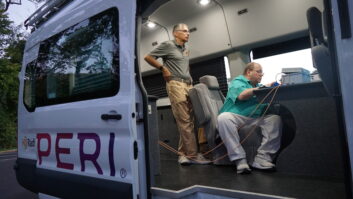The HD Radio System
May 1, 2006 12:00 PM, By Jeff Detweiler
If you are relative newcomer to Ibiquity’s HD Radio technology, it is easy to become overwhelmed by the alien hardware topology and a long list of acronyms used to describe multicast program channels and operating modes. One area sure to challenge all but the most progressive broadcaster is the available options for implementing HD Radio exciter technology.
To fully appreciate the benefits of each implementation, a thorough understanding of the technology is necessary. In the latter days of the Ibiquity commercial exciter development effort, a two-box approach consisting of the Generation-II exciter and the Exciter Auxiliary Service Unit (EASU) was conceived to deliver the first commercial platforms.
The Gen II was a far cry from its predecessor, the Gen I, having moved from a PC104-based platform using 14 Analog Devices SHARC processors, to a more conventional Intel Pentium IV PC architecture. The Gen II exciter consists of a motherboard with integrated video/LAN, 3GHz Intel Pentium processor, memory, touch-screen, video controller, AES audio cards, digital up-converter (DUC), RF up-converter (RFU), Station Interface Card (SIC), hard drive, CD drive, Linux operating system and the manufacturer-integrated version of the Ibiquity Reference System Software (IRSS). The EASU, which is also called the synchronizer, contains a GPS receiver/10MHz time base, word-clock generator, rate converter and audio bypass switching for maintenance. The Gen II platform accomplished the digital signals MPS audio bit-reduction and the multiplexing of the Program Service Data (PSD) to the MPS air interface. For the next four years the Gen II platform became the workhorse of HD Radio’s rollout.

A block diagram of the HD Radio transmission system. Click here to enlarge this image.
Once MPS was established, broadcasters became intrigued with HD Radio’s ability to deliver multiple, independent, program streams, over the same digital signal as Supplemental Program Services (SPS), which is now commonly referred to as multicast. SPS development was placed on a fast track and the importer platform was born.
With this background we can step through the HD Radio signal chain.
Importer
The importer contains the hardware and software necessary to deliver Advanced Application Services (AAS). Data service providers use an Application Programming Interface (API) to pass service data to the importer over the service link. The importer establishes session connections between multiple service providers. Once a session is established, service providers can pass service data over the importer-to-exporter link (I2E), which, in turn, will be broadcast over the air to HD Radio digital receivers. In addition to the AAS from data service providers, the importer also accepts SPS and PSD. The importer multiplexes all of the service provider data, multicast audio and data streams into a full-duplex TCP/IP or bi-directional User Datagram Protocol (UDP) output.
Conceptually, the importer is intended to be one component of a four-element platform. It was a technical response to a signal distribution challenge. For a radio station to convey linear 20kHz audio from the studio to the transmitter would require 1.4112Mb/s for each stereo channel. If broadcasters were expected to connect multiple stereo audio channels to the transmitter site for MPS and SPS, it makes sense to do so employing the HDC bit-reduced audio for transport efficiency. Accomplishing this requires bit reducing the MPS and SPS audio and PSD at the studio end of the system and conveying a single multiplexed data stream to a HD Radio exciter at the transmitter site. Around the same time, broadcasters began inquiring about an embedded system for the transmission end of the system to reduce complexity at the transmitter site. What emerged became known as the exciter engine, or exgine.
Exgine
The exgine subsystem accepts the exporter-to-exgine link (E2X) data from the exciter’s host processor and performs the Orthogonal Frequency Division Multiplexing (OFDM) modulation for the digital portion of the HD Radio waveform. The Exgine element is comprised of a Texas Instruments C64XX processor, SDRAM and Flash memory and enables the Layer 1 modulation to be executed on the Digital Signal Processor (DSP). The exgine element may be added to many manufacturers digital implementations of their analog exciter offering an integrated solution for low level analog and digital signal generation. In this distributed architecture, the HD Radio data stream is fed to the exgine over a simplex UDP Ethernet connection.
Exporter
To generate the multiplex over the E2X requires a new element in the system topology. The exporter answered this need by accepting the MPS AES audio and PSD from the automation server at the studio end as well as the multiplexed SPS audio, SPS PSD and advanced application service data from the importer. The exporter may be visualized as the final multiplexer of MPS and all Advanced Application Service (AAS) data prior to developing the simplex UDP stream to the STL. An exporter is essentially a Gen II exciter without the RFU and DUC sub-assemblies. In fact, some manufacturers allow maximization of the original equipment investment by providing and upgrade path from existing exciter to exporter.
The exporter contains the hardware and software necessary to generate the MPS and the Station Information Service (SIS). The MPS provides the main program audio and PSD broadcast over the air to HD Radio receivers. The SIS provides the station information (call sign, absolute time and position correlated to GPS).
The exporter accepts digital MPS audio over its audio interface, bit reduces (i.e. compresses) the audio and outputs the bit-reduced audio to the exgine over the simplex E2X. The exporter will also accept analog MPS audio over its audio interface and applies pre-programmed delay to it. This audio is broadcast as the backup channel for hybrid configuration. The delay compensates for the digital system latency allowing receivers to blend between the digital and analog program without a shift in time. In the FM system, the delayed analog MPS audio is returned to the synchronizer, which in turn is fed into the STL, and is stereo multiplexed and modulated by the analog exciter at the transmitter site.
Synchronizer
The synchronizer accepts MPS audio (a.k.a the studio feed) and rate converts it to the proper system clock. It outputs two copies of the MPS audio to the exporter: digital MPS audio and analog MPS audio where the digital MPS audio will be bit-reduced and modulated in the digital portion of the waveform and the analog MPS audio will be modulated in the analog portion of the HD Radio waveform. In many applications, there are two audio processors between the synchronizer and the exporter. Dual input and output audio processors may also be used for independent audio channel processing of the two streams.
The synchronizer provides the master system clock used by the exporter. This master clock is also synchronized to the exciter’s clock by use of the GPS unit. The synchronizer derives the master clock from an onboard GPS unit’s 10MHz output signal. This clock is used to rate convert the studio audio by use of the onboard rate converter unit via 44.1kHz word clock. The synchronizer is also used to bypass (or redirect) the analog MPS audio from being passed through the exporter in the event the exporter is removed for maintenance.
Like many systems, HD Radio has evolved from its original concept of delivering a single digital channel to become a content rich medium, offering more advanced application services. As this new digital paradigm emerges, the significance of importer/exporter/exgine link efficiency is paramount.
Detweiler is the director of broadcast technology of Ibiquity Digital.












